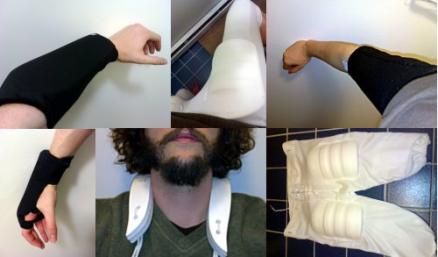thesis
Thesis Document
Hey, no sense keeping this hidden on my hard drive. And until we get a full and working archive of all the thesis documents back at the department, this seems like the most logical place for it to go. Plus it will allow me to link it into CiteseerX, which I'm currently doing research with and loving. While I'm thinking about it, I"m also loving JabRef, the open-source citation manager. Just wish I'd discovered these last year.
- Mike's blog
- Comments
- Read more



- 4940 reads
Comfort, Wearables, and a Peripersonal Space Experiment
I've been doing a lot of work on anthropometrics, and I found the articles for this week to be really helpful for my thesis research. I have been thinking about how to measure vital signs on a patient's body in a way that is inexpensive, accurate, and user-friendly, both for the patient and the technician. Equally important, however, is that a measuring device should be wearable, by the authors' definitions, if only for a short time.
In "The Comfort Assessment of Wearable Computers," by James Knight, et al., the authors invented a multidimensional test for describing the feelings of comfort or discomfort for a wearable device. I'm a freak for numbers and hard data, so it's nice to have this tool available to me for evaluating prototypes. I am especially glad to see how the evaluations are broken down, getting rid of the unhelpful, single variable comfortable/uncomfortable and allow researchers to get more toward the point of what actually is making the user uncomfortable with a device.
More specific to the design of the devices themselves, in "Design for Wearability" Gemperle et al. delineated the constraints for device placement, form, allowance of movement, peripersonal space, attachment, and several other considerations. For me, this could work as a checklist as I create new devices and wearables, making sure I've considered all of the problem areas. I especially appreciated their breakdown of good places to site the devices, which helps give me a starting point for how to shape and attach them.
Rounding out the readings, Dunne and Smyth's "Psychophysical Elements of Wearability" dove more into the neurological side of comfort, which I also liked. I have done a bit of work with haptic interfaces before, and the deadening of response to a continuous stimulus is something I've noticed. If you want the user to notice an output, the stimulus must be fresh. On the flip side, if you want the user to not attend to the device, it must be comfortable (that is, it must not irritate the nerves.)
I think the Dunne and Smyth article sums up something for me that I have been thinking about for a while. For a wearable to be successful, in my opinion, it must be peripheral. In their terms, it must be something that is subconsciously processed but not attended to. Important input from the wearable may be perceived by the user and later attended to, but it should otherwise fall into the background noise of the rest of the world.
With all this in mind, I conducted a little experiment with some equipment I picked up at Modell's, a local sporting goods chain store. I picked up a set of Adams Forearm Pads, Adams Football Pants, Adams Football Thigh Pads, Adams Neck Roll (flat contour), a pair of Trace Hand-Guard Plus, Nike Dri-FIT Sliding Pad, and a Nathan L.E.D. Wrist Runner. I put on the pants with the thigh pads inserted, put the forepad on my left forearm, the sliding pad on my upper right arm with the thickest part on my tricep, put the neck roll loosely over my shoulders, and put the hand guard on my left hand. Then I performed ordinary tasks to see how I reacted to these additions to my body in daily life.
 Collage of Sports Protection Equipment: First row: Adams Forearm Pad, Adams Football Thigh Pad, Nike Dri-FIT Sliding Pad Second row: Trace Hand-Guard Plus, Adams Neck Roll (flat contour), Adams Football Pants
Collage of Sports Protection Equipment: First row: Adams Forearm Pad, Adams Football Thigh Pad, Nike Dri-FIT Sliding Pad Second row: Trace Hand-Guard Plus, Adams Neck Roll (flat contour), Adams Football Pants
- Mike's blog
- Comments
- Read more



- 11968 reads
First Two Weeks
So far so good. I met with Marko this morning and worked through what needs to be done next. I have to start researching a lot about the patent and copyright situation with what I want to do, because I really want to make sure that this work is free (as in freedom) and that it stays free (i.e. no one scoops it up, locks it down, and sells it back to the people at high cost). I don't expect that to happen, but it's better to be safe than sorry, and I really want this to be shared as widely as possible.
Doing more work for Yury, too--top secret stuff for now. Should be really cool when it comes out, though. I was working in Processing today for some demo work, and I solved a lot of issues I'd had before with exporting apps and making them presentable. Sweet!
- Mike's blog
- Comments
- Read more



- 3877 reads
tags
Copyright Mike Edwards 2006-2009. All content available under the Creative Commons Attribution ShareAlike license, unless otherwise noted.
